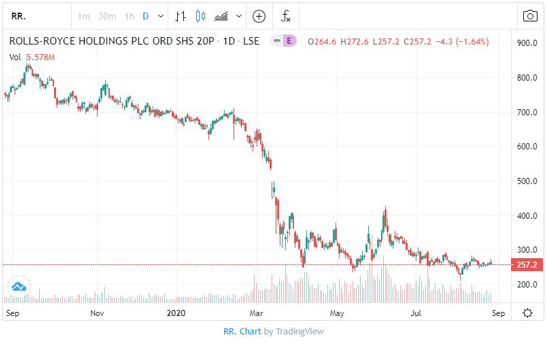
Wednesday, August 26, 2020
Can Rolls-Royce’s share price kick-start its engines?
By Century Financial in 'Brainy Bull'


Rolls-Royce’s [RR] share price has taken a nosedive so far this year, plunging 61.6% to close at 261.5p on 24 August.
Rolls-Royce’s share price reached an intra-day high of 711p on 13 February but dropped to a low of 245.89p on 9 April as the COVID-induced travel restrictions grounded planes and passengers. As a result of the subsequent reduction in flying hours, the engine maker spluttered amid decreased demand for its services.
Rolls-Royce’s share price staged a rally to 398p on 8 June, but this reprieve proved to be short lived.
Given the slump in demand for the company’s jet engines, can investors expect further trouble for Rolls-Royce’s share price when it announces its half-year earnings on 27 August?


Turbulence ahead for Rolls-Royce’s share price
According to the International Air Transport Association, global passenger numbers won’t return to pre-COVID-19 levels until 2024.
This forecast, combined with a horror-show first-half trading update in early July, sent Rolls-Royce’s share price to a low of 230p on 3 August.
In the trading update, Rolls-Royce said that its engine flying hours were down by 50% in the first half of the year and would likely fall by 55% over the full year. In addition, it reported free cash outflow of £3bn as a result of just £1.1bn in lower cash inflow.
The company’s power systems revenues declined by double-digits, as clients with exposure to oil and gas were battered by falling prices. The company expects this to recover by the end of next year, but Rolls-Royce’s share price is likely to remain low until it does.
In an effort to reduce cash expenditure, Rolls-Royce plans to cut 9,000 jobs — 17% of its workforce — mainly from its civil aerospace arm. It is reviewing options to strengthen its balance sheet through disposals, refinancing and a reported £1.5bn rights issue.


ValueAct Capital Management — once Rolls-Royce’s largest shareholder — exited its remaining 4.5% stake in April, raising concerns among investors of further dilution of Rolls-Royce’s share price value.
“An £8bn hole will need much more than a £1.5bn rights issue ... we believe Rolls-Royce needs to raise at least £6bn (through equity sales and disposals) to put itself on a sound footing,” David Perry, an analyst at JPMorgan wrote in a note to clients seen by This is Money.
Fitch Ratings gave the group a negative outlook in June. It expects a slow recovery rate with revenues not likely to reach 2019 levels until 2023. This reflects the “ongoing uncertainty of the impact from the coronavirus pandemic as well as the uncertain form and timing of a recovery for both aftermarket services and engine deliveries”.
It also pointed out continued operational problems — namely in its flagship Trent-1000 engines — dating back to 2017, which will increase risk in the short term.
Analysts strike a bearish note
While Goldman Sachs analysts believe Rolls-Royce can recover over the long term, they removed the stock from its conviction list in June, citing the “breadth of challenges and the range of potential outcomes”. The firm reiterated a Buy rating on the stock but reduced its 12-month target on Rolls-Royce’s share price to 528p.
“We believe Rolls-Royce will emerge from 2020 with a smaller than previously anticipated installed base, generating less cash and carrying more debt. The company continues to target a strong investment-grade credit rating and will seek to position itself to capitalise on medium-term growth opportunities,” the analysts said, according to FT Alphaville.


Among 20 analysts polled by MarketScreener,Rolls-Royce’s share price has a consensus Hold rating and an average target of 353p.
The pandemic came at a bad time for the group, which had just started to become cash-flow positive and had hopes of substantial cash profits in the years ahead.
“These predictions are now defunct,” Rupert Hargreaves, wrote in the Motley Fool. “It remains to be seen how long it’ll take the group to recover. It could be many years before the Rolls-Royce share price returns to 2019 levels.”
Looking ahead, Rolls-Royce faces challenges. The company does have fundamental strengths such as its product and geographical diversity. Its brand power and heritage should go a long way with investors, clients and governments.
But the company desperately needs to find the right solutions — some of which may become clearer at its results presentation — to prevent a fatal stall in Rolls-Royce’s share price, and its wider business.


Source: This content has been produced by Opto trading intelligence for Century Financial and was originally published on cmcmarkets.com/en-gb/opto
Disclaimer: Past performance is not a reliable indicator of future results.
The material (whether or not it states any opinions) is for general information purposes only and does not take into account your personal circumstances or objectives. Nothing in this material is (or should be considered to be) financial, investment or other advice on which reliance should be placed. No opinion given in the material constitutes a recommendation by Century Financial or the author that any particular investment, security, transaction or investment strategy is suitable for any specific person.
Century Financial does not endorse or offer opinion on the trading strategies used by the author. Their trading strategies do not guarantee any return and Century Financial shall not be held responsible for any loss that you may incur, either directly or indirectly, arising from any investment based on any information contained herein.















